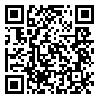BibTeX | RIS | EndNote | Medlars | ProCite | Reference Manager | RefWorks
Send citation to:
URL: http://jdisabilstud.org/article-1-3096-en.html
2- Assistant Professor, Department of Psychology, Semnan University, Semnan, Iran
Abstract
Background & Objectives: Panic disorder is a complex syndrome that begins with unexpected panic attacks, predicting subsequent defense mechanisms such as anxiety. Anxiety sensitivity is one of the variables that occur in individuals with panic. Anxiety sensitivity refers to the fear of anxiety–related feelings based on beliefs about physical, social, or cognitive adverse consequences. Studies have shown that high levels of neuroticism are associated with anxiety disorders, phobias, social anxiety, and depression. Childhood trauma and injury also play a role in panic disorders. The relationship between adverse childhood experiences and subsequent mental health problems such as adolescence and adulthood has been proven in many studies. So far, no research has been done to identify the factors impacting panic disorders in adolescents. Therefore, given the sensitivity of adolescence, it is necessary to research and identify the effective characteristics of panic disorders. Thus, this study aimed to compare anxiety sensitivity, neuroticism, and childhood trauma in adolescents with panic symptoms and normal adolescents.
Methods: This was a cross–sectional comparative study. The study's statistical population consisted of all second–high school students in Babol City, Iran, during the academic year 2021–2022. Using the multi–stage cluster sampling method, 460 questionnaires were completed by visiting schools. Among them, 60 adolescents who scored 20 or higher on the Acute Panic Inventory (Dillon et al., 1987) were selected as the panic group, and 60 normal adolescents who scored lower than 10 on the Acute Panic Inventory (Dillon et al., 1987) were randomly selected for comparison. The inclusion criteria were as follows: desire and informed consent and an age range of 15–18 years. The exclusion criterion was not fully answering the questions of the questionnaires. The research tools included the Acute Panic Inventory (Dillon et al., 1987), the Anxiety Sensitivity Index–Revision (Reiss et al., 1986), the NEO–FFI Personality Inventory (Costa & McCrae, 1992), and the Childhood Trauma Questionnaire (Bernstein et al., (2003). The obtained data were analyzed using an independent t test at a significant level of 0.05 with SPSS–21 software.
Results: Out of 60 samples with panic symptoms, 25 (41.7%) were boys and 35 (58.3%) were girls, and out of 60 normal samples, 27 (45%) were boys and 33 (55%) were girls. In the panic group, the highest age was 17 years, with 23 students (38.3%), and in the normal group 18 years with 24 (40%). Regarding educational level, the 12th grade was the most common in both groups (22 students in the panic group and 25 in the normal group). In the panic group, most students were studying in the field of humanities (30%), and in the normal group, most students were studying in experimental sciences (31.7%). The results showed significant differences in the mean anxiety sensitivity (t=–5.24, p<0.001), neuroticism (t=–7.59, p<0.001), and childhood trauma (t=–6.46, p<0.001) between the two groups of adolescents with panic symptoms and normal group.
Conclusion: According to the significant difference between anxiety sensitivity, neuroticism, and childhood trauma between adolescents in the panic group and the normal group, it can be said that the identification of risk factors plays a significant role in the prevention, treatment, and rehabilitation of adolescents with panic disorder. On the other hand, by identifying the risk factors, problems can be prevented in the future of the affected adolescents.
| Rights and permissions | |
 |
This work is licensed under a Creative Commons Attribution-NonCommercial 4.0 International License. |



